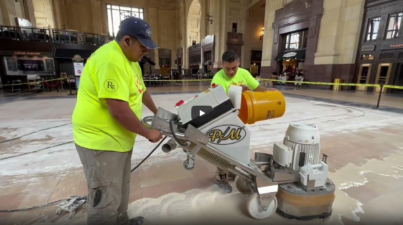Ice Melt is Good for Safety – But Not for Floors.
As a building owner, facility director or property manager, you have to keep your building’s sidewalks and parking lots ice-free, so you have used plenty of ice melt. If it all stayed outside, that would be great. But unfortunately, a lot of it remains on parking lots and sidewalks, where tenants and visitors walk through it and track it inside.
Some property or facility managers delay dealing with ice melt until spring. They figure it’s less costly to wait until all of the ice melt has been tracked in during the winter before dealing with it.
Nothing could be farther from the truth.
Damage from ice melt begins as soon as it lands on carpets and floors, so the best approach – and the most cost-saving in the long run — is to deal with it promptly throughout ice and snow season — and beyond.
Ice melt poses a real danger to your floors.
Ice melt enters your building in two forms: as crystals (solid) and as brine (liquid).
Ice melt contains rock salt (sodium chloride), magnesium chloride, calcium chloride, potassium chloride, urea, calcium magnesium acetate (CMA), sodium acetate (NAAC) and liquid glycol.
These chemicals mix with water to form a liquid solution. When the salt and this solution build up, it can leave a residue that causes significant damage to your carpets and floors. That is why it needs to be removed.
Crystals start on the surface of your carpet and work their way down.
When crystals are walked on, they work their way down to the base of the carpet, become embedded and begin to disintegrate the fibers. Vacuuming at least three times a day is recommended to remove most of the crystals. But when your carpet is wet with ice melt residue, it turns into a damaging brine.
The brine from ice melt is oily and sticky.
Brine attracts dirt and grime and clings to them. It can cause spots on your carpet and give it a crunchy texture. Soon, your expensive carpet looks old and weathered before its time.
On hard floors, brine is a slip-and-fall hazard. If untreated, brine will damage the floor. It can also produce a white residue, or haze, on the surface after the floor has dried. Floor cleaners that janitorial crews use to remove the haze will only remove it for a few minutes — and when it returns, it will be even harder to remove.
Embedded crystals, brine, dirt and grime in your carpet are tough to get rid of. Call a professional floor care company to perform water extraction to remove them. It’s possible your carpet may require more than one extraction.
Keep the ice melt outdoors.
One obvious way to minimize damage to carpets and floors is to keep ice melt from entering the building in the first place. Door mats inside every entrance will collect residue from visitors’ shoes before it’s tracked in.

Above is a diagram showing the recommended length and placement of entranceway floor mats. The longer the matting, the more residue it will capture.
Unfortunately, some ice melt will still make it onto your floors.
Routine mopping won’t be enough to remove it. Janitorial service floor cleansers don’t have the power to remove ice melt once it’s dried on the floor. Professional floor cleaning companies use cleansers that are specifically formulated to remove ice melt residue.
Ice melt is cheap. But the damage it does can cost a lot.
A little ice melt goes a long way, and using too much doesn’t increase its effectiveness; it just leaves more to get tracked in.
Every crystal or drop of brine can damage your carpets and floors and make expensive replacements necessary more frequently. Let us take care of ice melt right away.
We are subject matter experts in interior asset maintenance. Call us at 913-322-6200 to learn how you can extend the useful life of your carpets and floors with professional care throughout the year.

Mo Bashar, I.C.E. GB
Facility Care Specialist
913-530-2333
Fill out the form below to let us know how we can help you!




